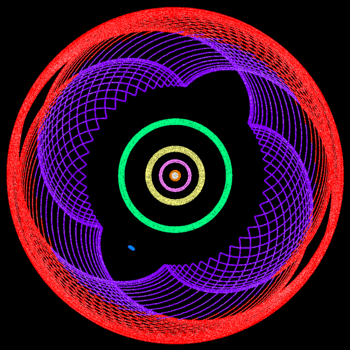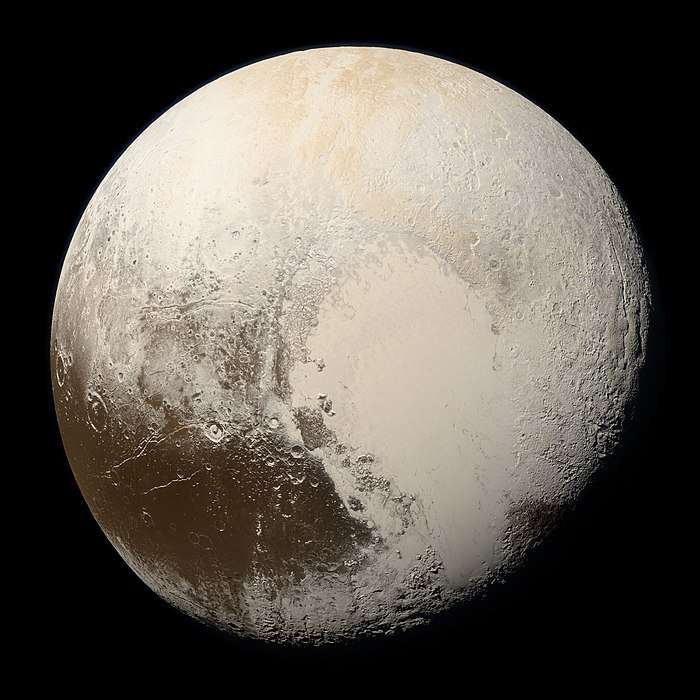(84522) 2002 TC302
(84522) 2002 TC302 is a red 2:5 resonant[3] trans-Neptunian object (TNO) discovered on 9 October 2002 by Mike Brown's team at the Palomar Observatory.[2]
 Hubble Space Telescope image of 2002 TC302 taken in 2005 | |
| Discovery[1][2] | |
|---|---|
| Discovered by | Michael E. Brown Chad A. Trujillo David L. Rabinowitz |
| Discovery site | Palomar Observatory |
| Discovery date | 9 October 2002 |
| Designations | |
| (84522) 2002 TC302 | |
| TNO · SDO · 2:5 resonant[3] · distant[4] | |
| Orbital characteristics[1] | |
| Epoch 31 May 2020 (JD 2459000.5) | |
| Uncertainty parameter 3 | |
| Observation arc | 18.24 yr (6,661 days) |
| Earliest precovery date | 5 August 2000 |
| Aphelion | 71.021 AU |
| Perihelion | 39.111 AU |
| 55.066 AU | |
| Eccentricity | 0.28974 |
| 408.64 yr (149,254 d) | |
| 325.763° | |
| 0° 0m 8.683s / day | |
| Inclination | 35.039° |
| 23.844° | |
| 86.805° | |
| Physical characteristics | |
| Dimensions | 543.2±18 × 459.5±11 km[5] |
Mean diameter | 499.6 km (area equivalent)[5] 584.1+105.6 −88.0 km (thermal)[6] |
| ~56.1 h[5] 5.41 h (dated)[7] | |
| 0.147[5] 0.115+0.047 −0.033[6] | |
| Temperature | <38 K |
| IR (moderately red)[8] B–V=1.03[9] V–R=0.67[9] | |
| 20.5[4] | |
| 4.23[5] 4.17±0.10[6] 3.9 (assumed)[1][4] · 4.2[10] | |
Discovery
2002 TC302 was discovered on 9 October 2002 by Mike Brown's team at the Palomar Observatory.[2] It has been observed 76 times back to 5 August 2000.[1]
Physical characteristics
2002 TC302 has an absolute magnitude (H) of 3.78.[1] It has an estimated diameter of 584.1+105.6
−88.0 km.[6] Using the Spitzer Space Telescope, it was previously estimated to have a diameter of 1145+337
−325 km,[8] which would have made it one of the largest possible dwarf planets. This overestimation was due to insufficient motion to allow for a good sky subtraction and because it was very close to a brighter background object.[6] Brown noted that the Spitzer measurement involved a very large potential error and that the object would likely be smaller, making its chances of it being a dwarf planet "likely" rather than "near certainty", in his opinion.[10]
The red spectra suggests that 2002 TC302 has very little fresh ice on its surface.[8]

Its rotation period was initially estimated by Thirouin et al. to be 5.41 h, based on a light-curve amplitude of 0.04±0.01 mag.[7] However, this short rotation period was most likely an alias due to a bias for shorter and more easily discernable shorter periods. 2002 TC302 is highly oblate, and Ortiz et al. suggest a longer rotation period estimate of 56.1 h.[5]
An occultation of a 15.3 magnitude star by 2002 TC302 on 28 January 2018 over Europe suggests that it has highly oblate shape with dimensions of 543.2±18 × 459.5±11 km and a projected axial ratio of a/c=1.18.[5] The area equivalent diameter of 2002 TC302 is 499.6 km.[5]
Possible satellite
The mean diameter of 2002 TC302 determined from occultations in 2018 is smaller than the larger diameter estimate of 584.1+105.6
−88.0 km by Spitzer in 2008. Despite the large uncertainty in the Spitzer's estimate, the difference of ~84 km between the two diameters is significant, implying that 2002 TC302 may have a large satellite with a possible size range of 100–300 km, nearly as large as 2002 TC302 itself.[11] This possible satellite is expected to orbit 2002 TC302 at a very close distance of less than 2000 km, close enough to slow down 2002 TC302's rotation through tidal interactions.[5]
If both the primary body and satellite are doubly tidally locked, then the expected orbital period of the satellite would be approximately 54 hours, equal to 2002 TC302's rotaton. Given an orbital period of 54 hours, the satellite's estimated semi-major axis from the primary would be 1780 km, with an angular separation of 0.058 arcseconds, too small to be resolved with current space telescopes such as Hubble. Under the assumption the satellite's diameter is 200 km, it would cause 2002 TC302's position to oscillate by 0.018 arcseconds as it orbits around its barycenter.[5]
Orbit and classification
2002 TC302 will come to perihelion in 2058.[1] Its perihelion (minimum distance from the Sun) of 39.1 AU[1] is about the same as Pluto's semi-major axis (average distance from the Sun). It is classified as a scattered disc object.[12][3]
Given the long orbit that TNOs have around the Sun, 2002 TC302 comes to opposition in late October of each year at an apparent magnitude of 20.5.[13]
Both the Minor Planet Center (MPC) and the Deep Ecliptic Survey (DES) show this probable dwarf planet to be in a 2:5 resonance with Neptune.[3][14] Due to the resonance, it completes two orbits for every five orbits of Neptune.
 A still frame showing the motion of (84522) 2002 TC302 relative to Neptune being held stationary. |
 The 2:5 resonance motion of (84522) 2002 TC302 (red) and the 2:3 resonance of Pluto (grey). Neptune is held stationary. |
See also
References
- "JPL Small-Body Database Browser: 84522 (2002 TC302)" (2018-10-31 last obs.). Jet Propulsion Laboratory. Retrieved 22 May 2020.
- Marsden, Brian G. (2002-11-07). "MPEC 2002-V26 : 2002 TC302". IAU Minor Planet Center. Harvard-Smithsonian Center for Astrophysics. Retrieved 2010-01-06.
- Marc W. Buie (2007-09-16). "Orbit Fit and Astrometric record for 84522". SwRI (Space Science Department). Retrieved 2008-09-19.
- "2018 VG18". Minor Planet Center. International Astronomical Union. Retrieved 22 May 2020.
- Ortiz, J. L.; Santos-Sanz, P.; Sicardy, B.; Benedetti-Rossi, G.; Duffard, E.; Morales, N. (18 May 2020). "The large Trans-Neptunian Object 2002 TC302 from combined stellar occultation, photometry and astrometry data". arXiv:2005.08881 [astro.PH].
- Fornasier, S.; Lellouch, E.; Müller, T.; Santos-Sanz, P.; et al. (July 2013). "TNOs are Cool: A survey of the trans-Neptunian region. VIII. Combined Herschel PACS and SPIRE observations of 9 bright targets at 70–500 µm". Astronomy & Astrophysics. 555: A15. arXiv:1305.0449v2. Bibcode:2013A&A...555A..15F. doi:10.1051/0004-6361/201321329. A15.
- Thirouin, A.; Ortiz, J.L.; Campo Bagatin, A.; Pravec, P.; et al. (21 August 2012). "Short-term variability of 10 trans-Neptunian objects". Monthly Notices of the Royal Astronomical Society. 424 (4): 3156–3177. arXiv:1207.2044. Bibcode:2012MNRAS.424.3156T. doi:10.1111/j.1365-2966.2012.21477.x.
- John Stansberry; Will Grundy; Mike Brown; Dale Cruikshank; et al. (2007). Physical Properties of Kuiper Belt and Centaur Objects: Constraints from Spitzer Space Telescope. arXiv:astro-ph/0702538. Bibcode:2008ssbn.book..161S.
- Tegler, Stephen C. (2006-01-26). "Kuiper Belt Object Magnitudes and Surface Colors". Archived from the original on 2006-09-01. Retrieved 2006-11-05.
- Michael E. Brown. "How many dwarf planets are there in the outer solar system? (updates daily)". California Institute of Technology. Retrieved 31 August 2016.
- Starr, Michelle (22 May 2020). "Astronomers May Have Spotted a Tiny Moon in The Outer Solar System".
- "List Of Centaurs and Scattered-Disk Objects". Minor Planet Center. Retrieved 2008-09-19.
- "(84522) 2002 TC302". Minor Planet Center. 2010-07-23. Retrieved 2010-10-24.
- "MPEC 2009-C70 :Distant Minor Planets (2009 FEB. 28.0 TT)". Minor Planet Center. 2009-02-10. Retrieved 2009-03-05.
External links
| Wikimedia Commons has media related to (84522) 2002 TC302. |
- TNO 2002 TC302, Image of the Month (January 2003)
- (84522) 2002 TC302 at the JPL Small-Body Database
_(cropped).jpg)
